Genre: Hack-‘N-Slash Developer: Beam Party Software Publisher: Electronic Arts Players: 1-2 Released: 1993
In 1993, Electronic Arts was still pumping out a diverse range of software for the Genesis. From ported computer games to Genesis-exclusive titles, players were getting games from a variety of genres. Some of these games were good, some became long running franchises, and others were done so poorly that time itself has tried to erase their existence. During this period, Blades of Vengeance was made by Beam Software and published by EA. Working with the medieval idea of swords, monsters and magic, the team set out to satiate Genesis players who still liked a good old fashioned hack-‘n-slash game. Does their effort score a fatal blow or wind up having its weapon break in the sheath? Read on.
A dark time has befallen the Kingdom. Manax the Dark Lady, using her magic and army of monsters, has driven those who follow the light of goodness from the land, leaving seemingly none to try and defeat her. But in this dark hour The Master summons three adventurers who may be able to best Manax, in hopes of freeing the Kingdom from her vile reign. With the promise of returning light to the land, the trio set out on a quest to find the Dark Lady and bring an end to the horrors she’s called forth.
In the area of graphics, the game comes off looking pretty good. There are nice details in the monsters, backgrounds and characters, the overall animation in the game is well done, and the designs, though not always particularly original, look fine. While the only big visual effect that game uses is the infamous wavering effect that Thunder Force III made famous among Genesis owners, it is used for a nice touch or two beyond the background usage on stage one; some torches have smoke wavering up from them, mist snakes back and forth, little things of that nature. There isn’t much visual depth to speak of, as there are really only two layers of parallax scrolling, the layer on which you interact and a usually static backdrop with not a lot of perceived depth drawn in it (though the forest does put a layer in front of the player). They’re not bad looking per se, they’re just rather flat. It’s a shame really, as some of the background designs could have featured several parallax layers easily. Even so, the visuals themselves are good.
When it comes to music, Blades of Vengeance holds its own. The songs range from a few more atmospheric pieces to catchy beats that blend a bit of rock into their composition. Unlike some EA games of the past, this one doesn’t suffer much from the infamous “EA sound driver” syndrome. There are a few instruments that aren’t as pleasant sounding as they could have been, but a good amount of the instruments sound fine. The end result is music that, while not something you’re likely to find yourself rocking out to, sounds good. On the other side of the aural coin, the sound effects don’t really stand out much. Swinging your sword, hitting an enemy/object, picking up treasure, a voice-like sample or two… they only do what’s needed and nothing more. They don’t offend thankfully, but they’re just… there.
The gameplay of Blades of Vengeance isn’t as bare bones as one might expect for a hack-‘n-slash game. One or two players get to choose from three characters: a curvy huntress, a muscle-bound barbarian, and a wrinkly old wizard. The characters all move and attack at about the same speed and take the same amount of damage when hit. However, they do have differences.
The first difference is with their jumps. The barbarian’s is the lowest, the huntress’ is the highest and the wizard’s is in-between. The second difference is with their attacks. The wizard’s is the weakest, but it’s a projectile attack. The barbarian’s is the strongest, but it’s close and has a poor reach. The huntress’s is in the middle, as it does more damage than the wizard’s and it’s close with a better reach than the barbarian’s. Of note is that all three characters can gain an armor and weapon upgrade later in the game, improving their attack and defense abilities. The wizard’s energy ball gets stronger and the barbarian gets a weapon with a better (but still close) reach, while the huntress gains a crossbow, giving her a projectile attack.
Speaking of attacks, these generally consist of a regular swing, a kneeling swing, a more powerful downward slash, and a blocking position when you squat down (yes, someone made a hack-‘n-slash where you can block enemy projectiles and the smaller enemies themselves). It should also be pointed out that hidden in various levels are power up items that strengthen your character’s attacks even more. You can collect up to two of these little sparkling objects, but keep in mind that you lose one each time you die.
To help keep you from an untimely death, there are quite a few items for you to find and buy in the game. Scattered around in treasure chests and on enemies are silver and gold bags that will allow you to purchase things like health, extra lives, armor, strength scrolls and other items between levels. You can also get items from the chests/enemies you hit. These things will come in handy as you make your way through each level and encounter the various monsters scattered within. Fire monsters, goblins, floating eyes, scythe-wielding skeletons, spikes, poison gas (which you’ll need a potion to protect yourself from)… it’s all waiting for you in the eight levels this game features.
The levels themselves have some decent diversity. A volcanic landscape, a forest, a castle at twilight, dungeons… though you’ll find yourself walking in or through a castle half the time. The levels start off simple in layout but get both a bit larger as the game progresses and increase in the number of sections between boss encounters. They have hidden areas to access where you’ll find extra goodies (like treasure, enemies, and the aforementioned sparkling power ups) and become filled with areas that require timing, patience and/or a needed item to proceed. They’re not massive, but the levels are big enough to become an obstacle and lead to you getting a bit lost in spots as you accidentally go back through an area you’ve already been in. And of course, at the end of each level awaits a boss.
Wizards, Medusa-like heads, fire-borns and the “woman” in question, Manax. As one would expect, they put up progressively tougher fights and offer up some decent challenges with their different attacks. They also have two or three “phases” to contend with. Once each boss has been damaged enough, their attack patterns change and usually become more difficult. Some simply speed up, some gain new abilities, and some do both. This is a nice touch to make the boss fights not so predictable in terms of simply learning a single pattern that carries through the entire battle.
This is where we get to the “That’s all well and good, but what’s wrong with the thing?” part. Really, there are only two major things wrong with the game. One is that there’s no save or password option. This is a long game to play through in one sitting, but that’s exactly what you have to do. Why some kind of save feature between levels wasn’t included is beyond me. The other main issue is that the music gets cut off a lot by sound effects. Sometimes you’ll even lose more than one instrument if multiple effects play in quick succession. It gets annoying at times, especially when the instrument returns, only to be cut off again two seconds later. This wouldn’t be so bad if the instruments came back immediately, but there are times when they won’t return for a good four or five seconds.
On the more minor side of things, there is respawning with the enemies. It’s not as horrific as say Atomic Robo-Kid or Ninja Gaiden, but it is there. The reason it’s not bad is that you don’t often get swarmed with more than five or six enemies at once. The levels aren’t as low in enemy count like Galahad‘s were, but they’re not coming out of the woodwork either. It’s a balance that makes for a generally steady stream of fighting, without causing the respawning to get overly frustrating. Oh, and there are no continues. When you lose your last extra guy, it’s game over. Be ready to scream profanities if this happens on the final level after two-plus hours of playing.
What can we say about Blades of Vengeance in the end? Essentially this… it won’t wow you, but it does what it set out to do pretty well. There are no big special effects, no complex moves to learn and not a lot in the way of huge leaps in creativity. But the graphics are solid, the music’s good, the controls are responsive, and the gameplay has a bit of extra depth to it on top of the “if it moves, slice it in two” basics. Passwords would have been nice and the music getting interrupted is annoying, but they don’t break the game. And with three characters to choose from, Blades of Vengeance does have some replayability going for it.
So, if you’re looking for a solid hack-‘n-slash to feed your Genesis, this one will do fine. It won’t win awards, but it will entertain.
SCORE: 7 out of 10

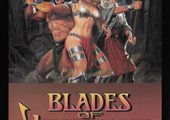
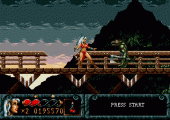
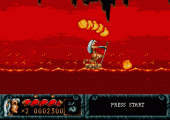
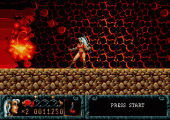
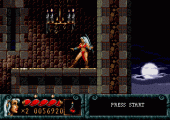
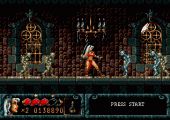
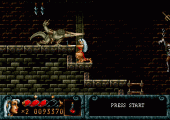
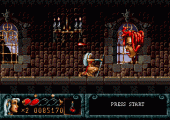
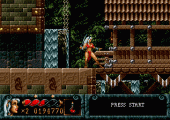
I love this game and am playing it right now. Good review,but I did have one problem with the review.The game does have continues. You earn continues based on your score. I think you get a continue for every 70 thousand points. I know I have continued at least twice.
Blade of Vengeance is one of my favorite genesis game. I loved how challenging the game was and how I was always making it a little tiny bit farther into the game every time I had to start over.
Hard game but very satisfying. The only real trouble I have with this game is the fact that you press down to block… I don’t know of another game who did this. Do you?
I actually like holding down to block and think it works very well for this type of game. My only problem is I can not seem to beat the game with any one,but the wizard.I used to be able to beat it with all the characters back in the day.